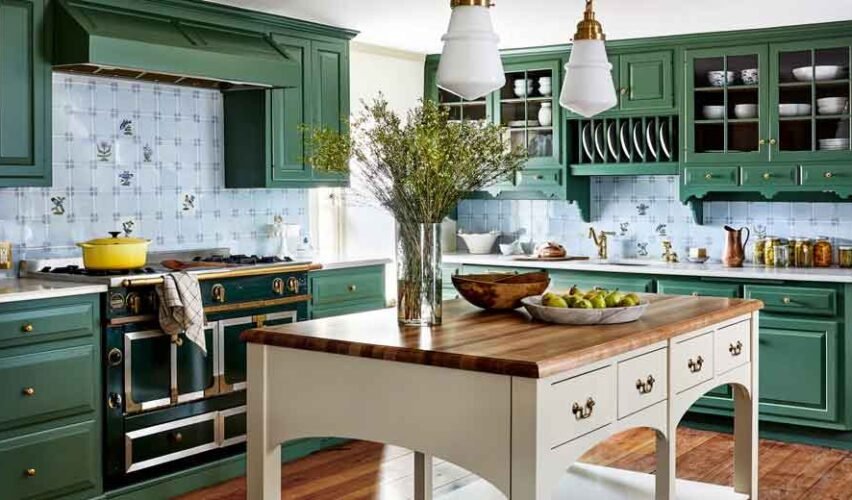Most kitchen backsplashes look amazing in magazines, but then reality hits. That gorgeous white subway tile starts showing every splash of tomato sauce within a week. The trendy dark grout that looked so sophisticated becomes a cleaning nightmare when dealing with actual cooking mess.
The truth is, a backsplash needs to work harder than just looking pretty. It’s got to handle grease splatters, steam from pasta water, and the occasional (okay, frequent) cooking disaster while still making the kitchen feel welcoming.
The Subway Tile Reality Check
Subway tiles remain popular for good reason, but not all subway installations are created equal. The classic white with dark grout might photograph beautifully, but families quickly discover that dark grout shows every bit of cooking residue. Light or matching grout makes maintenance much more manageable, though it won’t have quite the same dramatic contrast.
The size matters too. Standard 3×6 subway tiles work well in most kitchens, but larger format versions (like 4×8 or even 6×12) mean fewer grout lines to clean. Fewer grout lines equal less scrubbing, which busy families definitely appreciate.
Natural Stone: Beautiful but Demanding
Natural stone backsplashes can transform a kitchen, but they come with strings attached. Marble looks stunning until someone spills lemon juice on it and discovers the hard way that acidic substances etch the surface. Travertine and other porous stones need regular sealing, which many homeowners forget about until staining becomes an issue.
However, some natural stones handle kitchen life better than others. Granite and slate tend to be more forgiving, especially darker varieties that don’t show water spots as easily. Many homeowners find that stylish and affordable kitchen tiles from specialized suppliers offer the natural stone look with better durability and easier maintenance than genuine stone options.
The Unexpected Charm of Larger Tiles
Large format tiles have quietly become the secret weapon of practical kitchen design. A 12×24 tile creates fewer interruption lines, making the space feel larger while reducing cleaning time. The smooth surface is easy to wipe down, and there’s less grout to maintain.
These tiles work particularly well behind ranges where splashing is most intense. The uninterrupted surface handles heat better than smaller tiles with multiple grout lines, and cleaning becomes a simple wipe-down rather than detailed grout scrubbing.
Pattern Play That Actually Makes Sense
Herringbone patterns look incredible, but they’re honestly a pain to keep clean in a working kitchen. All those angles create spots where grease can hide. Same goes for tiny mosaic tiles, which have charm but require significant maintenance effort.
Instead, consider simple patterns that add visual interest without creating cleaning challenges. A basic brick pattern with rectangular tiles gives movement without complexity. Vertical installation of subway tiles creates height while keeping maintenance simple. Sometimes the most boring-looking option turns out to be the smartest choice for daily life.
Color Choices for Real Cooking
White backsplashes photograph well, but they show every single cooking mishap. Medium-toned tiles often work better for active kitchens. Gray, beige, or muted colors hide minor staining while still looking clean and fresh.
Dark tiles can be surprisingly practical too, though they show water spots more readily. The key is choosing tiles with some texture or variation rather than solid, flat colors that highlight every fingerprint.
Grout: The Make-or-Break Detail
Grout choice can make or break a backsplash installation. Dark grout looks sophisticated initially but shows soap residue, food particles, and general kitchen grime more obviously than expected. Light grout might seem like it would show dirt more, but it actually hides most cooking-related stains better.
Epoxy grout costs more upfront but resists staining and doesn’t need sealing like traditional grout. For busy kitchens, this extra investment often pays off in reduced maintenance time.
The Height Question
Standard backsplashes extend about 18 inches above the counter, but full-height backsplashes (going all the way to the ceiling or upper cabinets) have practical advantages. They protect more wall surface from cooking splatters and create a cleaner look with fewer transition points.
The downside is more tile to clean, but many families find the extra protection worth the additional maintenance. Plus, it eliminates the dust-catching ledge that forms where a short backsplash meets the wall.
Making It Work with Your Life
The best backsplash choice depends on how the kitchen actually gets used. Families who do lots of frying might want maximum protection with full-height, easy-clean surfaces. Weekend bakers might prioritize heat resistance behind the range. People who entertain frequently might choose materials that look good even when they haven’t had time for detailed cleaning.
Think about your actual cooking habits rather than aspirational ones. That elaborate mosaic might look amazing, but if weekly meal prep involves lots of sauce-making, simpler tiles might serve better.
A practical backsplash doesn’t have to be boring. It just needs to work with real life instead of against it. The most successful installations balance visual appeal with the kind of maintenance that actually fits into busy schedules. After all, the best backsplash is the one that still looks good after a year of actual cooking, not just the day it’s installed.



